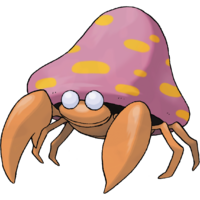From Bulbapedia, the community-driven Pokémon encyclopedia.
|
|

Artwork from FR/LG
|
|
|
|
|
|
|
|
|
|
|
|
Height
3'3"
Imperial
|
1 m
Metric
|
3'3"/1 m
Red-Striped
|
0'0"/0.0 m
Blue-Striped
|
0'0"/0.0 m
|
|
|
Weight
65 lbs.
Imperial
|
29.5 kg
Metric
|
65 lbs./29.5 kg
Red-Striped
|
0.0 lbs./0.0 kg
Blue-Striped
|
0.0 lbs./0.0 kg
|
|
|
|
|
|
|
|
|
|
|
|
|
EV yield
HP
0
|
Atk
0
|
Def
0
|
Sp.Atk
0
|
Sp.Def
0
|
Speed
0
|
| Base Exp.: 128
|
Battle Exp.: 1281*
|
|
|
|
|
Parasect (Japanese: パラセクト Parasect) is a Bug/Grass-type Pokémon.
Biology
Physiology
Gender differences
None.
Special abilities
Behavior
Habitat
Parasect can often be found in caves, since sunlight and dry air hurt their skin. They can also thrive in dank forests with lots of humidity where conditions are ideal for fungi.
Diet
Main article: Pokémon food
In the anime
Cassandra uses a Paras which evolves in EP044.
Officer Jenny uses a Parasect in AG065.
Game data
Pokédex entries
| This Pokémon was unavailable prior to Generation I.
|
| Generation I
|
|
| Red
|
A host-parasite pair in which the parasite mushroom has taken over the host bug. Prefers damp places.
|
| Blue
|
| Yellow
|
The bug host is drained of energy by the mushrooms on its back. They appear to do all the thinking.
|
| Stadium
|
The bug host is controlled by the mushrooms that scatter poisonous spores. The spores are sometimes used as medicine in China.
|
|
|
| Generation II
|
|
| Gold
|
It stays mostly in dark, damp places, the preference not of the bug, but of the big mushrooms on its back.
|
| Silver
|
The larger the mushroom on its back grows, the stronger the mushroom spores it scatters.
|
| Crystal
|
When nothing's left to extract from the bug, the mushrooms on its back leave spores on the bug's egg.
|
| Stadium 2
|
Unknown
|
|
|
| Generation III
|
|
| Ruby
|
Parasect is known to infest large trees en masse and drain nutrients from the lower trunk and roots. When an infested tree dies, they move onto another tree all at once.
|
| Sapphire
|
Parasect is known to infest large trees en masse and drain nutrients from the lower trunk and roots. When an infested tree dies, they move onto another tree all at once.
|
| Emerald
|
Parasect are known to infest the roots of large trees en masse and drain nutrients. When an infested tree dies, they move onto another tree all at once.
|
| FireRed
|
It scatters toxic spores from the mushroom cap. In China, the spores are used as herbal medicine.
|
| LeafGreen
|
A host-parasite pair in which the parasite mushroom has taken over the host bug. Prefers damp places.
|
|
|
| Generation IV
|
|
| Diamond
|
A mushroom grown larger than the host's body controls Parasect. It scatters poisonous spores.
|
| Pearl
|
It is controlled by a mushroom grown larger than the bug body. It is said to prefer damp places.
|
| Platinum
|
{{{platinumdex}}}
|
| HeartGold
|
{{{heartgolddex}}}
|
| SoulSilver
|
{{{soulsilverdex}}}
|
|
|
|
|
|
|
Game locations
| This Pokémon was unavailable prior to Generation I.
|
|
|
|
|
|
|
|
|
|
|
|
|
In side games
Base stats
| Stat
|
Range
|
| At Lv. 50
|
At Lv. 100
|
60
|
|
120 - 167
|
230 - 324
|
95
|
|
90 - 161
|
175 - 317
|
80
|
|
76 - 145
|
148 - 284
|
60
|
|
58 - 123
|
112 - 240
|
80
|
|
76 - 145
|
148 - 284
|
30
|
|
31 - 90
|
58 - 174
|
Total: 405
|
Other Pokémon with this total
|
- Minimum stats are calculated with 0 EVs, IVs of 0, and (if applicable) a hindering nature.
- Maximum stats are calculated with 252 EVs, IVs of 31, and (if applicable) a helpful nature.
- This Pokémon's Special base stat in Generation I was 80.
|
Of the first generation Bug Pokémon, Parasect ties with Butterfree, Beedrill and Scyther for the highest base SpDef.
Type effectiveness
Template:DP type effectiveness
In Generation I, the effectiveness of Poison-type moves is 400.
If Parasect has the ability Dry Skin, the effect of Water becomes 0, and Water attacks will heal 25% of Parasect's HP. In addition, the effect of Fire becomes 800.
Learnset
Template:Evolved learnset intro
Side game data
Template:Side game
Evolution
Trivia
Origin
There are many forms of fungus that grow on insects, any one of which could have inspired Parasect's design, like the entomophthora muscae, which grows on the back of the common housefly.
Name origin
Parasect's name is a combination of parasite and insect, referring to the parasitic mushroom on this insect's back.
In other languages
External links

|
This Pokémon article is part of Project Pokédex, a Bulbapedia project that aims to write comprehensive articles on each Pokémon species, as well as Pokémon groups and forms.
|


